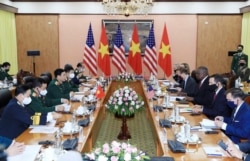U.S. President Joe Biden’s administration is looking for ways to align multiple Asian countries behind the containment of rival superpower China, analysts said this week following Defense Secretary Lloyd Austin’s visit to the region.
Austin advocated during a speech Tuesday in Singapore for a reduction of China's military activity in Southeast Asia through "integrated deterrence." Austin also traveled to the Philippines and Vietnam during the weeklong trip.
Integrated deterrence means using “every military and non-military tool in lock-step with allies and partners,” the U.S. Defense Department says on its website, citing space and cyberspace as two newer tools.
Experts say Austin selected Vietnam and the Philippines because both have sparred with China during the past decade over contested sovereignty claims in the South China Sea. The U.S. contends China’s claims to own much of the sea have “no basis in international law.”
“It’s not coincidental,” said Eduardo Araral, associate professor at the National University of Singapore's public policy school. “The U.S. just finished its China strategy. The core of the strategy is to get more allies on board, so it made sense that the first trip to Asia is in Southeast Asia because these countries would play some critical role.”
Backed by Asia’s strongest military, China has landfilled islets in the 3.5 million-square-kilometer sea between Hong Kong and Borneo for military use. It periodically sends vessels into the exclusive economic zones of other claimant countries.
Brunei, Malaysia and Taiwan call all or parts of the same waterway their own. All three are U.S.-friendly, though they also are keen to work with China economically. The U.S. government does not have a claim in the Asian sea but views China as a geopolitical rival that is bullying it neighbors.
Vietnam, the most vocal opponent of China’s maritime claims among Southeast Asian nations, has received U.S. military hardware, including Coast Guard cutters.
As trust builds between Vietnam and the United States, Washington likely will suggest more “naval cooperation,” including aircraft carrier visits and sales of American-made weapons, said Nguyen Thanh Trung, Center for International Studies director at University of Social Sciences and Humanities in Ho Chi Minh City.
The two countries fought a war that concluded in the 1970s, however, and Vietnam relies heavily today on China as a trading partner. Vietnam does not want a high-profile role in containing China, Nguyen said.
“Maybe they can play the observer status in some kind of a U.S.-led arrangement, but not the official commitment,” he said.
The Philippines and the United States have had a mutual defense treaty since 1951. The Southeast Asian country’s forces often train alongside American counterparts.
“It’s not just the U.S. wanting to rally them behind the United States in its own strategic competition with China, but it’s also the U.S. trying to help those countries to protect their sovereignty and territorial integrities,” said Alexander Vuving, professor at the Daniel K. Inouye Asia-Pacific Center for Security Studies in Hawaii.
On Thursday, timed for Austin’s visit, the Philippines announced it would retain a Visiting Forces Agreement with Washington, despite misgivings that surfaced in 2020 as Manila explored ties with Beijing.
“And with that long-range planning, we can actually do more comprehensive exercises,” the U.S. defense secretary said while in Manila.
Austin’s trip signals a longer-term revamp of former U.S. President Barack Obama’s pivot to Asia, Vuving said. During his presidency, Obama unveiled a diplomatic, military, and economic strategy to be applied from the Indian subcontinent through Northeast Asia but was criticized for not fulfilling the shift in policy.
China has largely avoided criticism of Austin’s visit to Southeast Asia. The country’s state-run China Daily news website on Friday played up the defense secretary’s comment that the “U.S. is committed to pursuing a constructive, stable relationship with China” and said his messages were “largely positive.”










